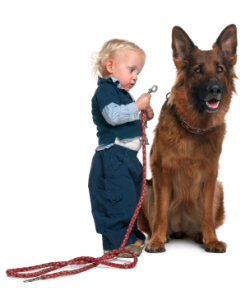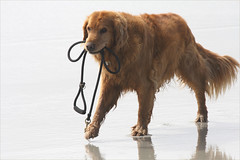 When the dog pays attention, a walk in the park or a training exercise are easy, fun and rewarding. When the dog spends the majority of the time looking for anything else to do besides focusing on the human, the same experiences can be frustrating and discouraging. There is a striking difference between different people’s ability to get their dog’s focus and attention. It’s about how interesting and inspiring they are to be around. The confidence level of the person holding the leash plays a determining role in the dog’s behavior.
When the dog pays attention, a walk in the park or a training exercise are easy, fun and rewarding. When the dog spends the majority of the time looking for anything else to do besides focusing on the human, the same experiences can be frustrating and discouraging. There is a striking difference between different people’s ability to get their dog’s focus and attention. It’s about how interesting and inspiring they are to be around. The confidence level of the person holding the leash plays a determining role in the dog’s behavior.
While I was working with men and women in prison, their individual differences and their effects on the dog’s reactions were quite evident. The dogs were often passed from one handler to another for generalization purposes of the service dogs in training. With one handler a dog was unresponsive and distracted, almost to the point where it was hard to tell she had received any training. With another handler, the same dog would be focused, alert, on task and showing a very high level of skills. In all cases, the handlers had clickers and treats. The main differences: the handler’s attitude, confidence and skill level.
When working with dogs, what we’re trying to do is to influence their behavior one way or another. Like a teacher or a leader, our goal is to inspire the dog to want to pay attention to us and interact with us. Although using the right treats and good timing is critical in the process, there are more subtle ingredients that can make the difference in the dog’s level of interest.
One of the main challenges offenders have to face when working with dogs is their lack of confidence. The prison environment clearly takes a toll on one’s ability to develop positive feelings about themselves. As a result, when holding a leash, certain offenders walk with their shoulders hunched, drag their feet, look down and tend to walk at a slow or even pace. When working with dogs, good technique is important, but the handler’s attitude also invariably influences the dog’s behavior. Dog training can become much more challenging without a positive and confident attitude from the person. The dog may respond to the click and come get the treat, but it can take very little distractions for the dog to lose his/her attention on the handler. There were many instances where the floor was clearly more interesting than the person on the other end of the leash! With pet owners, I have witnessed similar effects of the person’s lack of confidence and hesitation. Dog and handler are caught in a vicious cycle. The person’s attitude gets in the way of the dog’s ability to respond. The less the dog responds, the more the person gets discouraged, the more they get discouraged, the less they’re interesting and fun to the dog, …
Dog professionals need to have a strong understanding of dog behavior and training of course, but an even bigger and more challenging part of their job is to know how to communicate with the owner. Helping others develop confidence and trust in their ability to handle their dog is a key element to their success.
7 ways to help the dog focus on the handler:
- Walk with purpose. Nobody would want to follow someone who’s just walking without a goal. Even if it’s on a straight line, slowly and for a few feet, walking with intention is much more inspiring than strolling aimlessly.
- Stand straight, shoulders back and walk with confidence. Confidence inspires confidence. The more anxious and hesitant we are, the more anxious the dog. When a dog is worried that the person cannot handle the situation, they will tend to be on the lookout for potential problems, thus more distracted.
- Use proper equipment. There are plenty of tools on the market today that provide immediate control to owners who struggle when walking their dog. Trusting our ability to manage even the most difficult situations plays a key role in our confidence level.
- Act as a guiding and protecting parent or teacher. Being on leash, dogs have lost the ability to choose where to go and what to do. Remaining calm and providing the dog with some direction will encourage him to pay attention to you. It’s critical to stay relaxed, patient and calm.
- Relax the arm that holds the leash and folding the leash to make it the perfect length for both handler and dog. It’s also best to keep our arm down along side of our body or folded with our hand on our belly button. Avoiding nervously clamping on the leash while raising our arm up to your chest is also important.
- Be fun and interesting. Treating sufficiently, with good timing but also changing pace, direction,
 and making different sounds are all ways to keep the dog’s focus on the handler. The key is to learn when, what and how to do it at the right time. This point is often the most challenging for most beginners.
and making different sounds are all ways to keep the dog’s focus on the handler. The key is to learn when, what and how to do it at the right time. This point is often the most challenging for most beginners. - ‘Fake it ‘till you make it’. It’s so difficult to feel confident when still challenged with figuring out how to hold the leash, deliver treats, manage the dog around others, etc… It takes a certain level of knowledge and experience to truly develop the confidence that we know what we’re doing. Until then, the best approach is to just pretend that we do and act accordingly.
Jennifer Cattet Ph.D.
Related articles







Excellent article!
I have been looking for SO long for an article like this to refer people to 😉
Thank you,